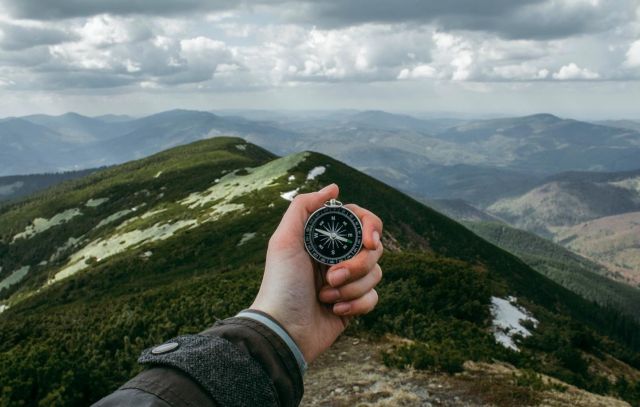Individual Differences in Navigation Ability and Strategy

Large Scale Spatial Ability:
Large scale or environmental spatial ability is important for everyday navigation tasks, such as learning the layout of a new place, maintaining a sense of direction and location while moving around an environment, finding our way to places we need to visit, and returning home at the end of the day. Despite the essential nature of spatial navigation, we all know people with an excellent sense of direction while others readily claim that they have no sense of direction. The Spatial Thinking Lab is concerned with understanding individual differences in navigation at both the cognitive and neural levels (Wolbers & Hegarty, 2010). For a summary of the lab's work on navigation, please see Professor Hegarty's talk on individual differences in navigation ability, part of a series by the Royal Institute of Navigation.
In past research on this topic, we examined the relations between large-scale spatial abilities used in learning spatial layout and small-scale spatial abilities, such as mental rotation (Hegarty, Montello, Richardson, Ishikawa, & Lovelace, 2006). We also developed new measures related to large-scale spatial spatial abilities including the Santa Barbara Sense-of-Direction Scale (Hegarty, Richardson, Montello, Lovelace, & Subbiah, 2002) and the Spatial Orientation test (Friedman, Kohler, Gunalp, Boone & Hegarty, 2019; Hegarty & Waller, 2004). Previous work in our lab has also investigated the spatial cues that support navigation and orientation in known environments (Burte & Hegarty, 2012; 2013).

Current research is focused on determinants of navigation strategies, for example, why some people navigate by familiar routes, whereas others use their knowledge of the layout of environments to take shortcuts to goal locations (Boone, Gong, & Hegarty, 2018; Boone, Maghen, & Hegarty, 2019). In a recent study conducted in the lab, Mable is interested in examining the influence of stress on navigation strategies, and how to train people to be resilient to stress; how the physical effort afforded by different user interfaces (i.e., physically walking on a treadmill versus using a mouse and keyboard on a desktop) and different types of trials influence people's decisions about which strategies they use to navigate to goals.

Using navigation tasks in both desktop virtual, immersive virtual and real environments, we are studying a variety of mechanisms underlying individual differences in navigation performance and strategies (see Hegarty, Burte & Boone, 2019; Hegarty et al., 2023). In a recent study conducted in the lab, Lexie tested whether spatial knowledge and wayfinding ability depend on the type of environment used (open irregular versus closed grid-like environments). Mable ran a real-world outdoor study examining the influence of distal landmarks, trait anxiety, and configural knowledge on wayfinding strategies.
Finally, in a new NSF-funded project, in collaboration with Elizabeth Chrastil, Jeffrey Kritchmar and Craig Stark, University of California, Irvine, we will combine methods and insights from cognitive psychology, cognitive neuroscience and robotics to understand variation in navigation abilities and strategies. The aims of this study are to 1) test whether human spatial navigation is a singular competence or whether multiple abilities contribute, 2) establish the neural markers of human navigational abilities through multi-modal imaging, and 3) implement and test different navigational abilities in robots in real-world situations.
References:
Boone, A. P., Gong, X., & Hegarty, M. (2018). Sex differences in navigation strategy and efficiency. Memory & Cognition, 46(6), 909-922.
Boone, A. P., Maghen, B., & Hegarty, M. (2019). Instructions matter: Individual differences in navigation strategy and ability. Memory & Cognition, 47(7), 1401-1414.
Burte, H., & Hegarty, M. (2012). Revisiting the relationship between allocentric-heading recall and self-reported sense of direction. In Proceedings of the Annual Meeting of the Cognitive Science Society (Vol. 34, No. 34).
Burte, H., & Hegarty, M. (2013). Individual and strategy differences in an allocentric-heading recall task. In Proceedings of the Annual Meeting of the Cognitive Science Society (Vol. 35, No. 35).
He, C., & Hegarty, M. (2020). How anxiety and growth mindset are linked to navigation ability: Impacts of exploration and GPS use. Journal of Environmental Psychology, 101475.
He, C., Boone, A. P., & Hegarty, M. (2023). Measuring configural spatial knowledge: Individual differences in correlations between pointing and shortcutting. Psychonomic Bulletin & Review, 30(5), 1802–1813. https://doi.org/10.3758/s13423-023-02266-6
Friedman, A., Kohler, B., Gunalp, P., Boone, A. P., & Hegarty, M. (2019). A computerized spatial orientation test. Behavior Research Methods, 1-14.
Hegarty, M., Montello, D. R., Richardson, A. E., Ishikawa, T., & Lovelace, K. (2006). Spatial abilities at different scales: Individual differences in aptitude-test performance and spatial-layout learning. Intelligence, 34(2), 151-176.
Hegarty, M., Richardson, A. E., Montello, D. R., Lovelace, K., & Subbiah, I. (2002). Development of a self-report measure of environmental spatial ability. Intelligence, 30(5), 425-447.
Hegarty, M., & Waller, D. (2004). A dissociation between mental rotation and perspective-taking spatial abilities. Intelligence, 32(2), 175-191.
Hegarty, M., & Waller, D. (2005). Individual differences in spatial abilities. The Cambridge Handbook of Visuospatial Thinking, 121-169.
Hegarty, M., He, C., Boone, A. P., Yu, S., Jacobs, E. G., & Chrastil, E. R. (2023). Understanding differences in wayfinding strategies. Topics in Cognitive Science, 15(1), 102–119. https://doi.org/10.1111/tops.12592
Jacobs, E. G., & Goldstein, J. M. (2018). The middle-aged brain: Biological sex and sex hormones shape memory circuitry. Current Opinion in Behavioral Sciences, 23, 84–91. https://doi.org/10.1016/j.cobeha.2018.03.009
Krichmar, J. L., & He, C. (2023). Importance of path planning variability: A simulation study. Topics in Cognitive Science, 15(1), 139–162. https://doi.org/10.1111/tops.12568
Topete, A., He, C., & Hegarty, M. (2025). Learning the layout of different environments: common or dissociated abilities?. Cognitive Research: Principles and Implications, 10(1), 6.
Wolbers, T., & Hegarty, M. (2010). What determines our navigational abilities? Trends in Cognitive Sciences, 14(3), 138-146.
Research Assistant Positions
Interested in applying to be a Spatial Thinking Lab Research Assistant?